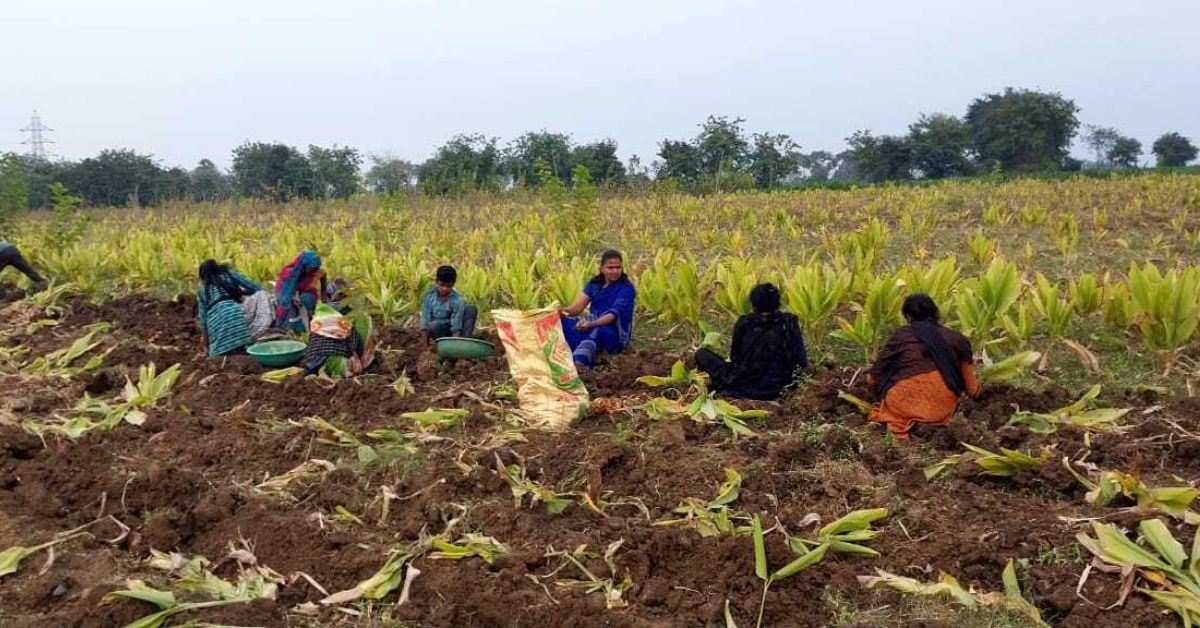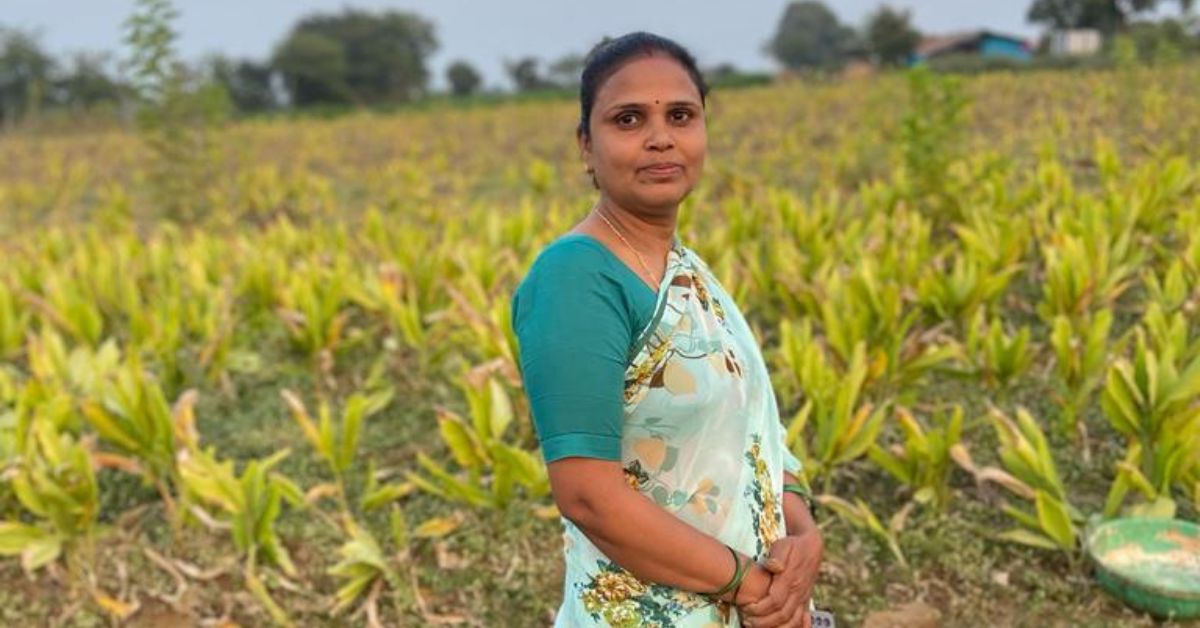
[ad_1]
Farmers historically domesticate wheat in Narmadapuram, Madhya Pradesh. However Kanchan Verma’s resolution to transition to turmeric farming resulted in elevated revenue. She makes use of natural strategies and likewise sells powdered turmeric for greater returns.
Situated on the financial institution of the Narmada river, Narmadapuram in Madhya Pradesh is known for its fertile black soil that yields high-quality wheat. In actual fact, the place is alleged to be competing with your entire state of Punjab for wheat manufacturing. With good canal irrigation amenities, the farmers, nonetheless, additionally domesticate crops of soybean, sugarcane, gram, and paddy.
Making an attempt one thing new, a progressive farmer Kanchan Verma ventured into turmeric farming within the division. “Though I didn’t face any losses cultivating conventional crops, I wished to discover new crops for higher returns. As a farmer, we should always maintain experimenting within the subject,” she tells The Higher India.
“By cultivating conventional crops, we had been capable of earn Rs 1.5 lakh in an acre. Whereas, we now have doubled our revenue to Rs 3 lakh by rising turmeric,” provides Kanchan, who lives in Somalwada Khurd village.
Final 12 months, Kanchan obtained a bountiful harvest of 400 quintals, incomes an revenue of Rs 12 lakh. We sat down with the farmer to learn the way she was capable of reap big income by switching to turmeric cultivation.

Previous subject, new crop, big success
Coming from an agricultural background, Kanchan turned to farming quickly after her marriage. Alongside cultivating greens, wheat, and maize, the BA graduate sowed turmeric for the primary time in 2020.
“As soon as, I noticed a programme on tv that showcased some great benefits of taking on turmeric farming. To be taught extra about it, I went to the close by KVK (Krishi Vigyan Kendra) and undertook a coaching programme of seven days,” she shares.
Kanchan opted for the Sangli number of turmeric which has excessive curcumin turmeric and is commonly used for medicinal functions. Along with its deep-orange color and wealthy aroma, Kanchan says, this selection produces massive roots in comparison with different indigenous varieties.
She procured eight quintals of kachhi haldi (seed) from KVK at Rs 40 per kg. “Thereafter, we began tilling the farmland to take away weeds and cut back the soil compaction [relieve the tightness of soil], and stage the soil. After seedbed preparation, we added 4 trolleys (1 trolley includes 40 quintals) of cow dung within the soil. We then sowed germinated kachhi haldi within the beds. The method is just like sowing any tuber crop like potatoes,” she informs.

In turmeric farming, the soil is normally mounded across the base of a plant to get massive rhizomes. At first, Kanchan says she didn’t know the proper time to earth up the plant. She later realized that it was completed a month after planting the crop.
Whereas the sowing interval is between June and July, the crop is prepared for harvest by February-end. She factors out that it is rather necessary to remember the type of soil used for cultivation. “Our area is known for black soil that’s appropriate for wheat cultivation. Nevertheless, a well-drained sandy loam soil wealthy in humus content material works effectively for rising turmeric,” she informs.
“Additionally, black soil is delicate when moist however varieties laborious blocks when it will get dry. So, we want a sandy loamy strong that’s well-drained. In our district, only some blocks together with our Kesla block have such soil,” she provides.
Speaking in regards to the fertilisers and pesticides required for reinforcing turmeric progress, she says, “We solely use cow dung and jeevamrut (liquid natural manure) to spice up the fertility of the soil. Apart from, as turmeric in itself is antiseptic and natural, there are fewer possibilities of pest assault. Even when pests assault the crop, we use Trichoderma biopesticides to manage the assault,” she says.
As she wished to watch out of rising a brand new crop, Kanchan sowed and used solely an acre of land to sow eight quintals of turmeric root. After eight months, she harvested bumper produce of 100 quintals.

Processing uncooked turmeric for good returns
After harvesting the rhizomes, Kanchan processes your entire produce to promote it in powdered type. “As soon as we wash the roots, we boil them in water and dry them fully below the daylight. Thereafter, we peel the roots and grind them. It takes about 15 days to course of the kachhi haldi (uncooked turmeric) into powder,” she says.
“In a batch of 100 quintals, solely 20 quintals are left after processing. However this step is extraordinarily advantageous as powder turmeric will get greater returns,” she provides.
Final 12 months, Kanchan earned Rs 3 lakh in opposition to the enter prices of Rs 50,000. At the moment, she has expanded turmeric cultivation on 10 acres of land. “This season, we anticipate an revenue of Rs 30 lakh,” she says with delight.
Curiously, Kanchan makes 1 kg packets of powdered turmeric and sells whole produce on the farm itself. “We don’t must go to the native market as we now have earned nice demand on the native stage. By the point any outdoors buyer reaches us, we now have normally bought all our produce. Additionally, we promote our natural turmeric at Rs 150 per kg in comparison with Rs 240 per kg within the native market. We don’t have any problem decreasing the worth as our price of manufacturing turns into much less with natural strategies,” she says.
Kanchan claims she is the primary such farmer to apply turmeric farming on this area.
“Native farmers right here had been reluctant to develop turmeric because it has an extended rising season however they ignored the truth that it provides definitive and big returns. Apart from having the ability to earn double revenue, it provides me immense contentment that I develop the produce organically. The extra we minimise using chemical pesticides, the extra toxin-free meals will likely be there for our youngsters to eat,” she shares.
Edited by Pranita Bhat. All images: Kanchan Verma.
[ad_2]